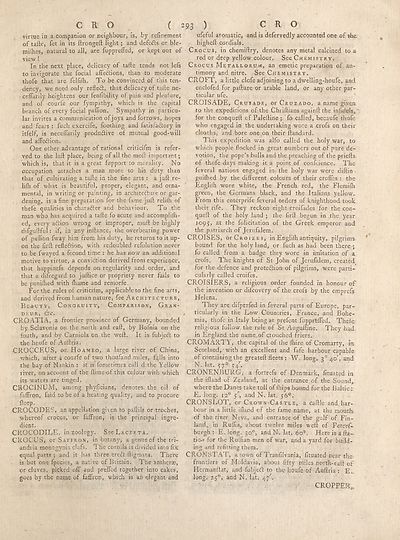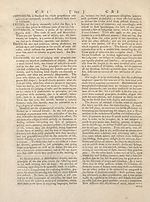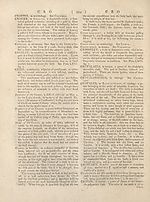Encyclopaedia Britannica; or, A dictionary of arts and sciences, compiled upon a new plan … > Volume 2, C-L
(321) Page 293
Download files
Complete book:
Individual page:
Thumbnail gallery: Grid view | List view

C R O ( 293 ) C R O
virtue in a companion or neighbour, is, by refinement
of taite, fet in its ftrongeft light; and defeds or b!e-
mifhes, natural to all, are fuppreffed, or kept out of
In the next place, delicacy of tafte tends not lefs
to invigorate the focial affections, than to moderate
thofe that are felfifh. To be convinced of tins ten¬
dency, we need only refled, that delicacy of tafte ne-
cefTanly heightens our fenfibihty of pain and pleafure,
and of courfe our fympathy, which is the capital
branch of every focial paflion. Sympathy in particu¬
lar invites a communication of joys andforrows, hopes
and fears : fuch exercife, foothing and fatisfactory in
itfelf, is neceffarily produdive of mutual good-will
and affedion.
One other advantage of rational criticifm is refer-
ved to the laft place, being of all the moft important;
which is, that it is a great fupport to morality. No
occupation attaches a man more to his duty than
that'of cultivating a tafte in the fine arts : a juft re-
lifh of what is beautiful, proper, elegant, and orna¬
mental, in writing or painting, in architedure or gar¬
dening, is a fine preparation for the fame juft relifh of
thefe qualities in charader and behaviour. To the
man who has acquired a tafte fo acute and accomplifh-
ed, every adion wrong or improper, muft be highly
difguftful: if, in any inftance, the overbearing power
of paffion fway him from his duty, he returns to it up¬
on the firft refledion, with redoubled refolution never
to be fwayed a fecond time : he has now an addition;:!
motive to virtue, a convidion derived from experience,
that happinefs depends on regularity and order, and
that a difregard to juftice or propriety never fails to
be punilhed with fhame and remorfe.
For the rules of criticilm, applicable to the fine arts,
and derived from human nature, fee Architecture,
Beauty, Congruity, Comparison, Gran¬
deur, <bc.
CROATIA, a frontier province of Germany, bounded
by Sclavonia on the north and eaft, by Bofnia on the
fouth, and by Carniola on the weft. It is fubjed to
the houfe of Auftria.
CROCCEUS, or. Hoameo, a large river of China,
which, after a courfe of two thotlfand miles, falls into
the bay of Nankin : it is fometimes call d the Yellow
river, on account of the flimemf this colour with which
its waters are tinged.
CROCINUM, among phyficians, denotes, the oil of
faffron, faid to be of a heating quality, and to procure
deep.
CROCODES, an appellation given to paftils or troches,
whereof crocus, or faffron, is the principal ingre¬
dient.
CROCODILE, in zoology. SeeLACERTA.
CROCUS, or Saffron, in botany, a genus of the tri-
andria monbgynia clafs. T he corolla is divided into fix
equal parts ; and it has three ered ftigmata. There
is but one fpecies, a native of Britain. The antherse,
or cluves, picked off and preffed together into cakes,
goes by the name of faffron, which is an elegant and
ufeful aromatic, and is defervedly accounted one of the.
higheft cordials.
Crocus, in chemiftry, denotes any metal calcined to a
red or deep yellow colour. See Chemistry.
Crocus Metallorum, an emetic preparation of an¬
timony and nitre. See Chemistry.
CROFT, a little clofe adjoining to a dwelling-houfe, and
enclofed for pafture or arable land, or any other par¬
ticular ufe.
CROISADE, Crusade, or Cruzado, a name given
to the expeditions of the Chriftians againftthe infidels.,
for the conqueft cf Paleftine ; fo called, becaufe thofe
who engaged in the undertaking wore a crofs on their
cloaths, and bore one on their ftandard.
This expedition was alfo called the holy war, to
which people flocked in great numbers out of pure de¬
votion, the pope’s bulls and the preaching of the priefts
of thofe days making it a point of confidence. The
feveral nations engaged in- the holy war were diftin ■
guilhed by the different colours of their crofles : the
Englilh wore white, the French red, the Flemifli
green, the Germans black, and the Italians yellow.
From this enterprife feveral orders of knighthood took
their rife. They reckon eight croifades for the con¬
queft of the holy land ; the firft begun in the year
1095, at the felicitation of the Greek emperor and
the patriarch of Jerufalem.
CROISES, orCaoizES, in Englifti antiquity, pilgrims
bound for the holy land, or fuch as had been there ;
fo called from a badge they wore in imitation of a
crofs. The knights of St John of Jerufalem, created
for the defence and proteftion of pilgrims, were parti¬
cularly called erodes.
CROISIERS, a religious order founded in honour oF
the invention or difeovery of the crofs by the emprefs
Helena.
They are difperfed in feveral parts of Europe, par¬
ticularly in the Low Countries, France, and Bohe¬
mia, thofe in Italy being at prefent fuppreffed. Thele-
religious follow the rule of St Augultine. They had
in England the name.of crouched friers.
CROMARTY, the capital of the ftiire of Cromarty, in
Scotland,-with an excellent and fafe harbour capable
of containing the greateft fleets : W. long.. 30 40', and
N. lat. 570 54'.
CRONENBURG, a fortrefs of Denmark, fituated in
the ifland of Zealand, at the entrance of the Sound,,
where the Danes take toll of Ihipa bound for the Baltic :
E. long. 120 5', and N. lat. 56°.
CRONSLOT, or Crown-Castle, a caftle and. har¬
bour in a little ifland of the fame name, at the mouth
of the river Neva, and entrance of the gulf of Fin¬
land,, in Ruffia, about twelve miles weft of Peterf-
burgh : E.long. 30°, and N. lat. 6o°. Here is a fta-
tio-i for the Ruffian men of war, and a yard for build¬
ing and refitting them.
CRONSTAT, a town of Tranfilvania, fituated near the:
frontiers of Moldavia, about fifty miles north-eaft of
Hermanftat, and fubjeeft to the houfe of Auftria : E„
long. 250, and N. lat. 47'.
CROPPER,,
virtue in a companion or neighbour, is, by refinement
of taite, fet in its ftrongeft light; and defeds or b!e-
mifhes, natural to all, are fuppreffed, or kept out of
In the next place, delicacy of tafte tends not lefs
to invigorate the focial affections, than to moderate
thofe that are felfifh. To be convinced of tins ten¬
dency, we need only refled, that delicacy of tafte ne-
cefTanly heightens our fenfibihty of pain and pleafure,
and of courfe our fympathy, which is the capital
branch of every focial paflion. Sympathy in particu¬
lar invites a communication of joys andforrows, hopes
and fears : fuch exercife, foothing and fatisfactory in
itfelf, is neceffarily produdive of mutual good-will
and affedion.
One other advantage of rational criticifm is refer-
ved to the laft place, being of all the moft important;
which is, that it is a great fupport to morality. No
occupation attaches a man more to his duty than
that'of cultivating a tafte in the fine arts : a juft re-
lifh of what is beautiful, proper, elegant, and orna¬
mental, in writing or painting, in architedure or gar¬
dening, is a fine preparation for the fame juft relifh of
thefe qualities in charader and behaviour. To the
man who has acquired a tafte fo acute and accomplifh-
ed, every adion wrong or improper, muft be highly
difguftful: if, in any inftance, the overbearing power
of paffion fway him from his duty, he returns to it up¬
on the firft refledion, with redoubled refolution never
to be fwayed a fecond time : he has now an addition;:!
motive to virtue, a convidion derived from experience,
that happinefs depends on regularity and order, and
that a difregard to juftice or propriety never fails to
be punilhed with fhame and remorfe.
For the rules of criticilm, applicable to the fine arts,
and derived from human nature, fee Architecture,
Beauty, Congruity, Comparison, Gran¬
deur, <bc.
CROATIA, a frontier province of Germany, bounded
by Sclavonia on the north and eaft, by Bofnia on the
fouth, and by Carniola on the weft. It is fubjed to
the houfe of Auftria.
CROCCEUS, or. Hoameo, a large river of China,
which, after a courfe of two thotlfand miles, falls into
the bay of Nankin : it is fometimes call d the Yellow
river, on account of the flimemf this colour with which
its waters are tinged.
CROCINUM, among phyficians, denotes, the oil of
faffron, faid to be of a heating quality, and to procure
deep.
CROCODES, an appellation given to paftils or troches,
whereof crocus, or faffron, is the principal ingre¬
dient.
CROCODILE, in zoology. SeeLACERTA.
CROCUS, or Saffron, in botany, a genus of the tri-
andria monbgynia clafs. T he corolla is divided into fix
equal parts ; and it has three ered ftigmata. There
is but one fpecies, a native of Britain. The antherse,
or cluves, picked off and preffed together into cakes,
goes by the name of faffron, which is an elegant and
ufeful aromatic, and is defervedly accounted one of the.
higheft cordials.
Crocus, in chemiftry, denotes any metal calcined to a
red or deep yellow colour. See Chemistry.
Crocus Metallorum, an emetic preparation of an¬
timony and nitre. See Chemistry.
CROFT, a little clofe adjoining to a dwelling-houfe, and
enclofed for pafture or arable land, or any other par¬
ticular ufe.
CROISADE, Crusade, or Cruzado, a name given
to the expeditions of the Chriftians againftthe infidels.,
for the conqueft cf Paleftine ; fo called, becaufe thofe
who engaged in the undertaking wore a crofs on their
cloaths, and bore one on their ftandard.
This expedition was alfo called the holy war, to
which people flocked in great numbers out of pure de¬
votion, the pope’s bulls and the preaching of the priefts
of thofe days making it a point of confidence. The
feveral nations engaged in- the holy war were diftin ■
guilhed by the different colours of their crofles : the
Englilh wore white, the French red, the Flemifli
green, the Germans black, and the Italians yellow.
From this enterprife feveral orders of knighthood took
their rife. They reckon eight croifades for the con¬
queft of the holy land ; the firft begun in the year
1095, at the felicitation of the Greek emperor and
the patriarch of Jerufalem.
CROISES, orCaoizES, in Englifti antiquity, pilgrims
bound for the holy land, or fuch as had been there ;
fo called from a badge they wore in imitation of a
crofs. The knights of St John of Jerufalem, created
for the defence and proteftion of pilgrims, were parti¬
cularly called erodes.
CROISIERS, a religious order founded in honour oF
the invention or difeovery of the crofs by the emprefs
Helena.
They are difperfed in feveral parts of Europe, par¬
ticularly in the Low Countries, France, and Bohe¬
mia, thofe in Italy being at prefent fuppreffed. Thele-
religious follow the rule of St Augultine. They had
in England the name.of crouched friers.
CROMARTY, the capital of the ftiire of Cromarty, in
Scotland,-with an excellent and fafe harbour capable
of containing the greateft fleets : W. long.. 30 40', and
N. lat. 570 54'.
CRONENBURG, a fortrefs of Denmark, fituated in
the ifland of Zealand, at the entrance of the Sound,,
where the Danes take toll of Ihipa bound for the Baltic :
E. long. 120 5', and N. lat. 56°.
CRONSLOT, or Crown-Castle, a caftle and. har¬
bour in a little ifland of the fame name, at the mouth
of the river Neva, and entrance of the gulf of Fin¬
land,, in Ruffia, about twelve miles weft of Peterf-
burgh : E.long. 30°, and N. lat. 6o°. Here is a fta-
tio-i for the Ruffian men of war, and a yard for build¬
ing and refitting them.
CRONSTAT, a town of Tranfilvania, fituated near the:
frontiers of Moldavia, about fifty miles north-eaft of
Hermanftat, and fubjeeft to the houfe of Auftria : E„
long. 250, and N. lat. 47'.
CROPPER,,
Set display mode to:
![]() Universal Viewer |
Universal Viewer | ![]() Mirador |
Large image | Transcription
Mirador |
Large image | Transcription
Images and transcriptions on this page, including medium image downloads, may be used under the Creative Commons Attribution 4.0 International Licence unless otherwise stated. ![]()
| Encyclopaedia Britannica > Encyclopaedia Britannica; or, A dictionary of arts and sciences, compiled upon a new plan … > Volume 2, C-L > (321) Page 293 |
|---|
| Permanent URL | https://digital.nls.uk/144917476 |
|---|
| Attribution and copyright: |
|
|---|
| Description | Ten editions of 'Encyclopaedia Britannica', issued from 1768-1903, in 231 volumes. Originally issued in 100 weekly parts (3 volumes) between 1768 and 1771 by publishers: Colin Macfarquhar and Andrew Bell (Edinburgh); editor: William Smellie: engraver: Andrew Bell. Expanded editions in the 19th century featured more volumes and contributions from leading experts in their fields. Managed and published in Edinburgh up to the 9th edition (25 volumes, from 1875-1889); the 10th edition (1902-1903) re-issued the 9th edition, with 11 supplementary volumes. |
|---|---|
| Additional NLS resources: |
|

